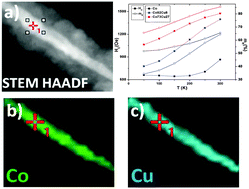Magnetization reversal dependence on effective magnetic anisotropy in electroplated Co–Cu nanowire arrays
Abstract
Arrays of Co(100−x)Cu(x) (0 ≤ x ≤ 27) nanowires with 45 nm of diameter and 18 μm in length have been potentiostatically electrodeposited into the hexagonally self-assembled nanopores of anodic alumina membranes. The structural characterization of Co–Cu nanowires confirms the coexistence of both hcp and fcc crystalline phases, with textures that are strongly affected by the fractional content of Cu. Parallel magnetic studies of the room temperature magnetization process by First Order Reversal Curve (FORC) analysis and the angular dependence of coercivity confirm the presence of two coexisting ferromagnetic phases on intermediate Cu content nanowires, ascribed to a softer magnetic phase for pure Co and a harder magnetic one for the Co–Cu composition alloy, respectively. The temperature dependence of coercivity and remanence reveal a reorientation of the effective magnetic anisotropy with the addition of Cu to the Co–Cu alloy nanowires, being enhanced by the coexistence of the two ferromagnetic phases.


 Please wait while we load your content...
Please wait while we load your content...